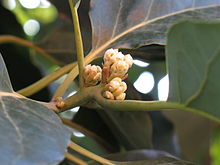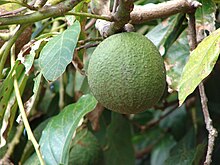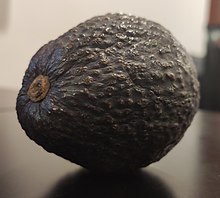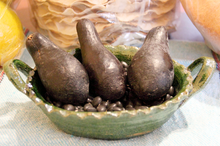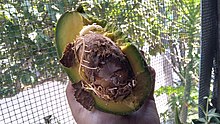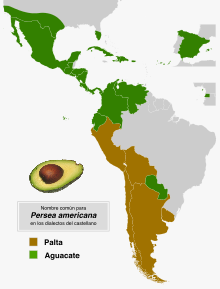American persea
Persea americana, popularly called avocado, avocado (Argentina, Bolivia, Chile, Peru and Uruguay) or aguacatero (Dominican Republic, Puerto Rico and Venezuela), is an arboreal species of the genus Persea belonging to the family Lauraceae, whose fruit, the avocado or avocado, is an edible berry. It is a species native to Mesoamerica, specifically from the highlands of central and eastern Mexico, Guatemala and El Salvador. The oldest evidence of its use was found in Coaxcatlán (Mexico) and dates back about 10,000 years. Currently, the species is cultivated in places with tropical and Mediterranean climates throughout the world. The great demand for avocado has made its plantations transform large extensions of native ecosystems.
Description
In the wild, the tree can reach heights of around 20m, most commonly 8-12m, and a diameter at breast height of 30-60cm, with an erect or twisted trunk. Trees in plantation, generally derived from grafts and subjected to formative pruning, show a very different appearance. Crown: spreading, globular or bell-shaped, with low branches, young branches at first, yellowish-green, later becoming dull and with prominent leaf scars. Bark: rough, sometimes longitudinally furrowed.
The trunk has a gray-green bark with longitudinal fissures. The leaves alternate with a 2 to 5cm petiole and a blade that is generally glaucous on the underside. Narrowly elliptic, ovate or obovate, 8 to 20cm by 5 to 12cm and leathery, green in color and scarcely pubescent on the upper surface, although very densely on the underside, which is yellowish-brown in color and where the midrib stands out.. It has a wedge-shaped base and a sharp apex. The margins entire and more or less wavy.
The inflorescences are panicles 8 to 14cm long, with 5 to 6mm hermaphroditic flowers, with a densely pubescent perianth, with a very short tube and six oblong tepals, half a centimeter long, the three outer ones being shorter. They have nine fertile stamens of about 4 mm, with pubescent filaments, organized in three concentric circles. The ovary is ovoid, approximately 1.5mm long, densely pubescent, with a 2.5mm pubescent style, ending in a somewhat dilated discoidal stigma. The flowers open and close throughout the day in a cycle in which the functionality of the feminine and masculine parts alternates. This mechanism is called synchronized protogynous dichogamy.
The fruit is an oval or pyriform berry, depending on the variety, of a very varied size (7 to 33cm long and up to 15cm wide), green to dark purple skin, which can be thin, thick, smooth or slightly rough, sometimes with a leather-like appearance. Firm, oleic pulp, of a color that varies from yellow to light green. It contains a large seed (5 to 6.4 cm), hard and heavy, round or pointed, ivory in color. It has two very thin, brown papery casings that often remain attached to the pulp. The fruit is generally pear-shaped, sometimes ovoid or globose, 8 to 18 cm long, with a more or less tuberculate corky epicarp. and fleshy and edible mesocarp. The latter closely surrounds a globular seed of papyraceous episperm (integument), without endosperm, about 5 to 6 cm.
Eight varieties have been described, of which three are widely known: the Mexican (Persea americana var. drymifolia), the Guatemalan (Persea americana var. guatemalensis) and the West Indian (Persea americana. var. americana).
The specimens of P. americana native to the highlands of central and eastern Mexico generate the Mexican variety.
The trees native to the highlands of Guatemala generate the Guatemalan variety.
The Caribbean variety comes from the Antilles, and it is believed that it was the first variety found by Europeans, as that was the first area they arrived at.
There are discrepancies regarding the origin of the Antillean breed, since it is also possible that the first avocado specimens had been introduced to the Antilles from Mexico by the Spanish or the English during colonization.
The three varieties of P. americana naturally mixed with each other through their own reproduction system. The result of these fusions, produced through cross-pollination, gave rise to countless indefinite natural hybrid varieties.
History
The ancestors of the genus Persea arose in the northern part of North America, but between the Miocene and Pliocene they migrated to Mesoamerica. It is thought that the speciation that gave rise to Persea americana, may have had as its main factor the geological processes that occurred in Mexico. Fossil evidence suggests that similar species spread even further, up to the Northern California (USA), millions of years ago, at a time when the climate of that region was more favorable.
There is evidence of its consumption in the Tehuacán Valley (Puebla, Mexico), which is between 9,000 and 10,000 years old. Its domestication occurred in the Mesoamerican region, around the year 5000 a. C. and around the year 3000 a. C., it was consumed in Caral, in present-day Peru.
According to the Florentine Codex (1540-1585), ancient cultures had a good knowledge of the avocado and its variants: «aoacatl» could be Persea americana var. drymifolia (Mexican race), «tlacacolaocatl» to Persea americana var. americana (Antillean race) and «quilaoacatl» to Persea americana var. guatemalensis (Guatemalan race).
The Mendocino Codex (years 1540) shows hieroglyphics indicating the town of Ahuacatlan ("place where the avocado abounds"), which is made up of a tree with a tooth on the stem ("ahuacacahuitl") and a "calli » which means town or place. In the case of the tribute license plate that was given to the Aztec Empire and that was used to identify the merchandise of the town of Ahuacatlan, this was the "ahucacahuitl".
In the province of Cajatambo in the Viceroyalty of Peru in the 17th century, the Spanish missionary extirpating idolatry Pablo José de Arriaga narrates a propitiatory party for the ripening of the avocados called "acataymita":
Another more harmful abuse than this, Dr. Alonso Osorio discovered and punished in his visit. And it is that in the month of December, that the Paltas begin to mature, they made a party called Acataymita, which lasted six days with their nights, so that the fruit matured. Men, and boys, gathered themselves together in a place of a bare orchard in leathers, and where they ran to a hill, which was very great, and with the woman, who reached in the race, they had excess. They preceded this feast, by vigil, five days of fasting, not eating, going out, not aji, nor coming to women.Pablo José de Arriaga
The removal of idolatry in Peru, 1621.
Starting in the 1900s, the specimens of this species began to be selected, with the best attributes to win consumers in the markets, giving rise to the different cultivars that led the world markets until the 1930s. The new varieties They were well marketed, until in 1935 a new variety called Hass was patented in the United States, of unknown parents, originating in La Habra, a place in California, where Rudolph Hass detected it among the trees of his vegetable patch.
Soil and climate requirements
Climate and soil requirements vary with different varieties. The Antillean variety prefers a humid tropical climate, and is cultivated from sea level to 800 m a.s.l. no. m. (meters above sea level), with average temperatures of 24 to 26°C, and is very susceptible to frost. The Guatemalan variety grows between 500 and 2400 m a.s.l. no. m., with average temperatures of 22 to 25°C, and can tolerate temperatures not lower than 4.5 °C. The Mexican variety can grow up to 2800 m s. no. m., with average temperatures of 20°C, and can tolerate frosts of up to −4°C. P. americana grows in dry to humid climates, with rainfall between 800 and 2000mm, with well-defined dry seasons of up to six months, although it grows best with shorter dry seasons. On the other hand, it requires more than three dry months for good fruit production. The periods of heat and drought can cause the fruit to drop, especially in the mountain varieties. Sites that are too humid are not appropriate, due to the greater possibility of the occurrence of certain soil diseases, to which the species is highly susceptible. It adapts to a wide variety of soils, from sandy to clayey, volcanic silt, lateritic, and limestone, but grows best on loamy, well-drained, slightly acidic soils rich in organic matter. The West Indian tolerates limestone and slightly saline soils. Neither variety tolerates heavy, poorly drained soils and should not be planted where the water table is less than 1m from the surface. The optimum pH range is considered to be between 6 and 7, although some Florida cultivars grow well in soils with a pH of 7.2 to 8.3.
Conservation status
Genetic evidence allows us to sustain that the domestication process of P. americana has occurred more than once and that the Mexican variety P. American var. dryimifolia is one of the varieties that has contributed genetic material to modern avocado cultivars. Genetic diversity within P. americana is high. Most of the studies are based on the analysis of populations or collections corresponding to the ways of cultivating the avocado, and greater genetic diversity has been found in the cultivars of Mesoamerica, in relation to places where there are no wild populations of the genus Perseus. On the other hand, to date the wild populations have not been sufficiently studied and there is a deficit in the knowledge of genetic variation in native varieties.
Taxonomy
Persea americana was described by British horticulturist and botanist Philip Miller and published in The Gardeners Dictionary: eighth edition in 1768.
- Etymology
Persea: generic name used by Theophrastus that derives from the Greek in honor of Perseus, the demigod of Greek mythology, to designate an oriental tree.
American: geographical epithet that alludes to its location in America.
Cultivation and commercialization
Currently, P. americana has a wide distribution and market.
Cultivars
- 'Méndez': from Mexico. Original Variety. Thin, rough skin, peels easily, green to dark when ripe. The pulp is creamy and fiberless. It occurs in high seasons and is the only variety it produces when others do not. Name of variety referred to its creator, Carlos Méndez Vega.
- Avocado criollo, variety that grows naturally in the highlands of Mexico. It is characterized by a very thin and dark edible skin when mature.
- 'Fuerte': originating from Mexico and Central America. The skin, slightly rough, is easily separated from the flesh.
- 'Hass': from California. Thick and rough skin. It is peeled easily and has a dark green color when it matures. The pulp is creamy and fiberless. It is one of the most resistant varieties to low temperatures.
- 'Edranol'
- 'Bacon': from California. Its skin is fine and bright green.
- 'Negra de La Cruz': is known as Prada or Vicencio. It originated in the town of Olmué, in the Region of Valparaíso, Chile, by natural hybridization, in which there could have been some influence of the Mexican variety 'leucaria'. The skin is black or purple. It is called a "chilena" or "La Cruz" stick because it is its largest production place in the municipality of La Cruz, where the best fruits come from. Along with the Hass variety, they are the most resistant varieties to low temperatures.
- 'Torres': variety originated by hybridization and selection in the town of Famaillá, province of Tucumán, Argentina, where is the plantation of this variety.
- 'Ettinger': thin, thin, shiny skin. One of the main producers is Israel, where it represents between 25% and 30% of the plantations.
- 'Carmero': native variety of the region of El Carmen de Bolivar, Colombia. Green to dark skin when it has matured completely. It is smooth, easily separated from the flesh. The pulp is creamy and fiberless. It's between March and July.
- 'Pahua' or 'palto': thick peel and oily-looking pulp; pleasant taste.
- 'Azul' or 'black': from thin shell and abundant pulp, is another of the varieties that occur in Mexico in the regions of Tancitaro, Uruapan and Peribán, much smaller than their competitors the variety Hass and Mendez: this is due to its low commercialization as it is more "delicate" for its transport at large distances.
- 'Lorraine, Trash and Mariquiteño' cultivated in Colombia.
Production and consumption
In 2017, 5 million tons were produced, with Mexico with 30% (1,520,000 tons) of the total (see table). Other large producers are: Dominican Republic, Peru, Indonesia and Colombia, totaling 1,380,000 tons or 27% of world production (see table).
In the United States, per capita consumption has grown from 1kg in 2001 to 3kg in 2016.
According to Trade Map, as of 2016, Peru ranks as the second world avocado producer (by volume) only behind Mexico.
Production and export
Avocado is produced in approximately 46 countries. The total area harvested in the world reached 436.3 million hectares in 2009, being, in order of importance, Mexico, Indonesia, the Dominican Republic, the United States, Colombia, Peru, Kenya the main producers. Particularly Mexico, the main producer, exceeding one million tons per year (1316,104 tons in 2012), followed by Indonesia and the Dominican Republic. Likewise, Mexico is considered the most important "distributor" worldwide, participating with 51.4% of the export market, thus supplying a large part of the world population. America concentrates 60% of world plantations. In Mexico alone, it is produced in 28 states, Michoacán being the most important of them, with 85.9% of total production in 2009. 95% of national production is concentrated in the states of Michoacán, Jalisco, Nayarit, Edo. from Mexico and Morelos. Crops are grown in very fertile, semi-humid mountains. In these areas the winters are cold and during the summer the temperature rarely exceeds 32°C. The cold below 4°C damages the flower and therefore the production, in this microclimate the best quality avocado is produced.
For its part, among the main avocado exporting countries is Mexico, with 51.4% of the market, followed to a lesser extent by Israel (11.6%), Peru (15%) and South Africa (8, 0%). In 2010, the main avocado importing countries were the United States (47.1%), France (12.8%), Japan (6.1%) and Canada (4.9%), the which concentrate 70.8% of total imports. The Axarquía region, belonging to the province of Malaga, is the main avocado-producing area in the country, and is also considered the European tropical reserve. In the state of Michoacán, the region that includes the municipalities of Tancítaro, Uruapan and Peribán, is the number one nationally and internationally in production of this fruit, known as the world capital of avocado. It should be noted that this region is conducive to the production of "Hass" avocado due to its hot-humid climate in summer and cold in winter without exceeding temperatures of 4 degrees Celsius, the "Méndez" variety occurs in a warmer climate still and at a lower altitude, but the fruit is of lower quality, in terms of size, pulp and flavor. The city of Fallbrook (California) proclaims itself without recognition of any official body The world capital of the avocado.
The leaders of international trade are Israel, South Africa and Spain, countries that were the main exporters since 1993. The world avocado trade has increased significantly since 1980, and in the case of Mexico it has been limited to the US. and Europe. Japan has begun to import large volumes of the fruit, being the main importer in Asia.
The main suppliers to Europe are Israel, Chile, Peru and South Africa. Mexico exports to 21 countries, mainly the United States, Japan, Canada, Central America and Europe.
Disputes in international trade
North American Free Trade Agreement
After the North American Free Trade Agreement (NAFTA) went into effect in 1994, Mexico attempted to export avocados to the United States. The US government resisted on phytosanitary grounds, arguing that the trade would introduce Tephritidae fruit flies that would destroy California plantations. The government of Mexico responded by inviting inspectors from the United States Department of Agriculture, but the US government rejected the proposal, claiming that it was not possible to carry out an inspection of the fruit fly. The Mexican government then proposed selling avocados only to the Northeastern part of the United States in the winter, since fruit flies cannot withstand extreme cold. The United States government stood by its position, until finally relenting when the Mexican government began to place barriers on US corn. In 2009, Peru joined Chile and Mexico as exporters of avocados to the United States.
Socio-environmental impact of cultivation
Water crisis in Chile
According to an analysis by the Water Footprint Network, avocado cultivation required for the period 1996-2005 a total of 1981 cubic meters/tonnes of water globally, calculating both surface and groundwater (849m 3/t), rainwater consumed (283m3/t) and fresh water (849m3/t). In the Quillota area, in the Petorca River basin, in Chile, it was estimated in 2008 that the cultivation of one hectare of avocado required a rate of 1,100 liters per hour. In 2014, the National Institute of Human Rights issued a report on the water crisis caused by the cultivation of avocados in the areas of La Ligua and Petorca, where up to 65 illegal drainage works diverted for avocado cultivation were found. Several members of civil society organizations, such as Rodrigo Mundaca of the Defense Movement for Access to Water, Land and Environmental Protection (MODATIMA) have been threatened and persecuted by den report irregularities in the management and granting of rights to water in the area of La Ligua and Petorca. The scarcity of water in the areas of La Ligua and Petorca was addressed in the episode "Guerras de la palta" from the Netflix series Rotten.
Deforestation
Both in Michoacán and Chile, avocado cultivation has meant an advance in the agricultural frontier that has led to the deforestation of native forests, even through illegal logging. Added to this is agricultural contamination as a result of use of pesticides and pesticides to protect avocado trees.
Impact on pollinators
Insecticides are used in avocado cultivation, such as Confidor Forte 200 SL, which uses imidacloprid, a systemic neonicotinoid insecticide that affects several pollinators, including bees. Imidacloprid also affects beneficial species for the avocado Avocado crop, such as Neoseiulus californicus, which keeps other avocado pests away.
Uses
It has a high content of vegetable oils, which is why it is considered an excellent food in terms of nutrition in moderate proportions, since it has a high caloric and fat content. In addition, avocado oil has been found to have antioxidant properties. It is rich in vegetable fat that provides benefits to the body and in vitamins E, A, B1, B2, B3, fatty acids, proteins, minerals.
Gatronomic use
The fruit of P. americana has been used mainly for food.
In Mexico and Central America, avocados have been an important and traditional part of the daily diet since before the arrival of Europeans. It is used as an accompaniment to bread, as an ingredient in salads, as a garnish and to prepare guacamole, among many other uses. In Tocumbo, Michoacán, it is also used to accompany “French potatoes”.
Different varieties are cultivated with different characteristics, such as the color and thickness of the skin or the size of the fruit. Avocado leaves are used fresh or dried as a seasoning for various dishes, such as barbecue, mixiotes and enfrijoladas.
In Chile, there is a type of black-skinned avocado sometimes called a Chilean avocado. It is a widely consumed food and used in various ways in the gastronomy of this country. Avocado is used as an accompaniment to meals, as an ingredient in salads, or even as an accompaniment to bread, generally being consumed in savory recipes. It is very commonly used in so-called completes (name given in this country to hot dogs).
In Peru, the avocado that is produced mostly is a green variety that is native to the country itself. The size of the fruit can reach up to 15 centimeters, depending on the production area. It is used as an accompaniment or ingredient in various dishes of Peruvian cuisine, such as stuffed avocado, avocado soup, stuffed cause or avocado sandwich.
In Venezuela it is used mainly as an accompaniment, seasoning it with salt and in salads, as well as in the preparation of the Reina Pepiada arepa and the guasacaca.
In Colombia, the most widespread avocado has green skin and yellow flesh. It is used in salads (with tomato, onion and coriander), in guacamole, alone or with a little salt to taste, as an accompaniment to foods such as dry meat and for sancochos, bandeja paisa and ajiaco santafereño. The Carmero avocado variety is highly appreciated, from the region of the municipality of El Carmen de Bolívar. In Buenaventura (Valle del Cauca) the so-called fresh avocado is made, which consists of mixing it with milk and sugar.
In Argentina, the avocado consumed is generally black. With a black skin when ripe, it is a food that is often eaten along the coast of the country, being used as a dressing. It is also used to make "dulce de avocado," which is achieved by peeling the fruit, scooping out the pulp, mashing it, and adding sugar. It has a sweet and sour flavor and is used to accompany food or for direct consumption with bread.
Its use is common for making sushi.
Allergies
Some subjects present allergic reactions to the consumption of the fruit. There are two main forms of allergy: people with an allergy to tree pollen develop local symptoms in the mouth and throat shortly after eating avocado; the second, known as latex fruit syndrome, is related to latex allergy, and symptoms include generalized hives, abdominal pain, and vomiting, and is sometimes fatal.
Medicinal use
A traditional use of P. americana, less popular, is the medicinal plant. Its fruit and oils are used as beauty products, both for the skin and hair, and its leaves are used to make expectorants. It is also used to make medicines for the symptomatic treatment of osteoarthritis.
Etymology of Common Names
Avocado
The word "avocado" comes from the Nahuatl ahuacatl [aːwakat͡ɬ], which goes back to Proto-Aztec *PA:WA, which also meant 'avocado'. In Nahuatl this word also means 'testicle', probably due to the similarity between the fruit and the male gonads.
The fruit of Persea americana is known by this name, and its derivatives, in Mexico, most of Ecuador, most of Paraguay, Venezuela, Colombia, the United States, Central America, the Caribbean, Spain and Anglo-Saxon and Portuguese-speaking countries.
The word guacamole comes from the Nahuatl ahuacamolli, 'avocado sauce'.
Also known as "aguaco" or "ahuaca" and the tree is called an "avocado" or "avocado tree".
Avocado
By this name it is known mainly in Argentina, Bolivia, Chile, Peru, Uruguay, some Quechua-speaking areas of Ecuador and some areas of Paraguay close to Bolivia and Argentina.
The word "avocado" comes from Quechua, being the name by which an Amerindian ethnic group is known, the paltas, who inhabited the Ecuadorian province of Loja and northern Peru. This is probably the region described as the «province of Avocado» by the Inca Garcilaso de la Vega in his work Comentarios Reales de los Incas of 1601.
The region of the avocados was conquered by Túpac Inca Yupanqui during his march to conquer the province of Cañar. That would be the origin of the name with which the Incas baptized the fruit of this species, brought from the northern part of their empire. Also the approximate time in which the tree arrived from Ecuador to Peru, since it is known that the conquest of the northern provinces by Túpac Yupanqui occurred between 1450 and 1475.
Spanish writings mentioned this fruit for the first time in 1519.[citation required]
In countries where the fruit is called "avocado" the tree receives the name of "palto".
Contenido relacionado
Elephantidae
Allocasuarina
Agavoideae

